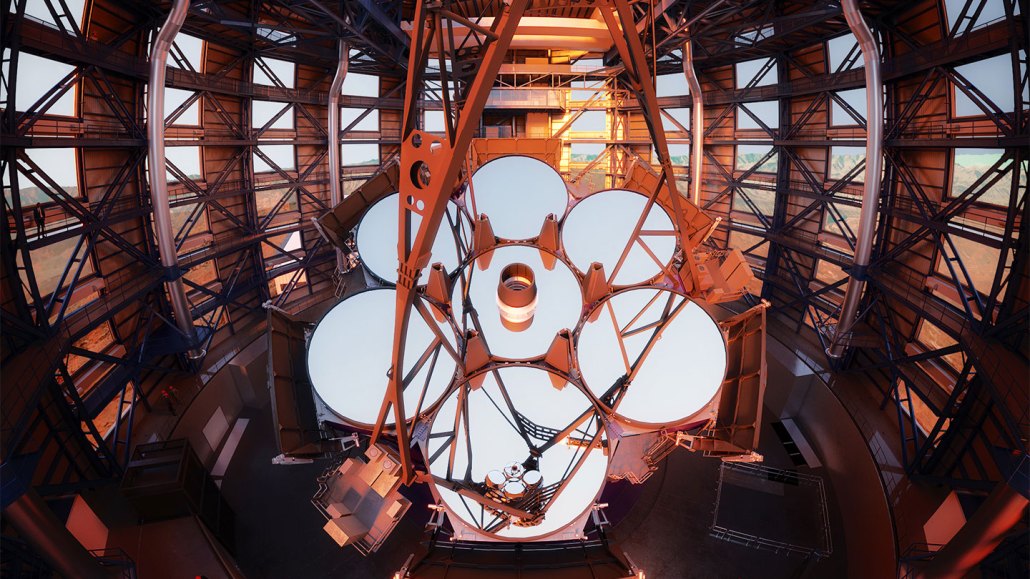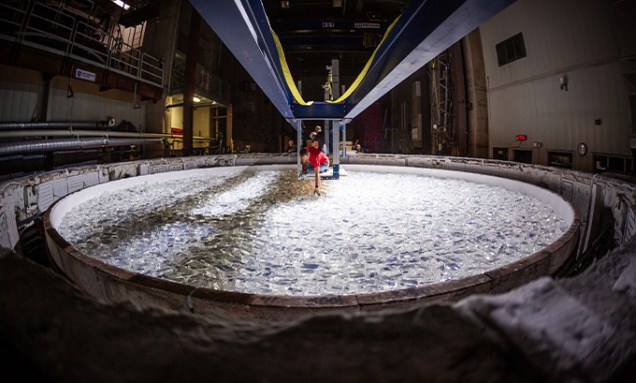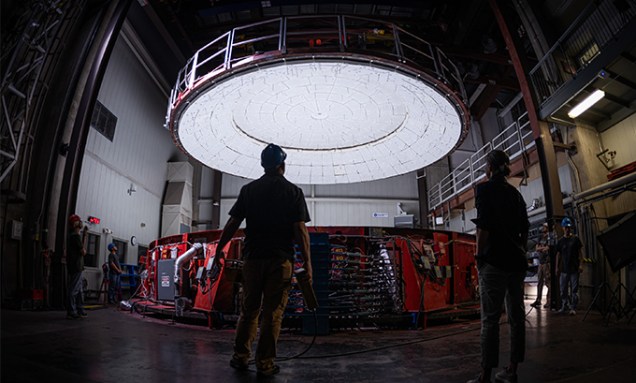
When completed, the Giant Magellan Telescope (shown in this rendering) will use seven huge primary mirrors to capture light from faraway, Earthlike worlds and search their atmospheres for potential signatures of life.
Giant Magellan Telescope/GMTO Corporation
TUCSON — Hot and dry air, perfused with a scent reminiscent of a warmed hair straightener, stuffed a hangar-sized room beneath the football stadium at the University of Arizona. The space, part of the Richard F. Caris Mirror Lab, was dominated by a gyrating, carousel-sized furnace, fire truck red and shaped like a flying saucer. The swirling cocoon of a colossal light collector.
“It’s making 4.9 revolutions per minute,” says astronomer Buell Januzzi of the University of Arizona, raising his voice over the lab’s droning ventilation system. About half past noon on October 7, after about a week of gradual warming, the temperature inside the rotating machine had finally peaked at 1165° Celsius.
In the heart of that inferno, nearly 17,500 kilograms of borosilicate glass — roughly four semitruck loads — had melted into a crystal clear fluid. If all goes to plan, the molten material will anneal to form the body of an enormous mirror — one as tall as a two-story house, if stood on edge. The mirror is the last of seven needed to capture light for what will be the world’s most powerful optical instrument, the Giant Magellan Telescope.
Slated to start operating in the late 2020s, the telescope, developed by an international consortium of research institutions, will repose on a mountaintop in Chile’s Atacama Desert, beneath some of the clearest night skies on Earth. There, within a yet-to-be-built, 22-story enclosure, the seven primary mirrors will be united in a flowerlike formation, Januzzi explains. “We’ve got six petals, and one in the middle.”
Together, the mirrors will function as a single unit, about as wide as an adult blue whale is long, that reflects light into the telescope’s secondary mirrors and, ultimately, its scientific instruments. This shiny expanse will provide the new telescope with an image resolution at least four times that of today’s most advanced space telescopes.
And unlike the James Webb Space Telescope, best suited for measuring infrared light emitted by hot celestial bodies, the Giant Magellan Telescope will excel at capturing optical and near-infrared wavelengths of light emitted by cooler, Earthlike worlds (SN: 8/20/23; SN: 3/27/23). That’s light that could potentially carry signatures of alien life.
“It’s going to give us the opportunity to find potentially habitable planets,” says astrobiologist Antígona Segura of the National Autonomous University of Mexico in Mexico City.
Current instruments may be able to measure a particular exoplanet’s mass, says Segura, who isn’t involved with the telescope’s construction. And sometimes, researchers may even be able to detect certain molecules in a large exoplanet’s atmosphere when it passes in front of its star. This new telescope, however, will be able to directly measure a smaller planet’s atmosphere, without relying on a starlight backdrop, and detect much more of what floats within.
The telescope’s name originates with Ferdinand Magellan, leader of the first expedition to circumnavigate the globe. Some astronomers have called for renaming the galaxies known as the Magellanic Clouds, due partly to the explorer’s brutal actions toward Indigenous people (SN: 9/26/23). But according to a spokesperson from the consortium constructing the telescope, no decisions have yet been made to change the telescope’s name.
In the meantime, the marathon that is the casting of the mirrors continues. It took about eight years to fabricate JWST’s segmented, 6.5-meter-wide mirror. Casting the Giant Magellan Telescope’s primary mirrors — each nearly 8.5 meters wide — has been ongoing for roughly 18 years.
Starting with a glass-loaded furnace, it takes about a week to bring the enclosed material to peak temperature, causing it to melt and flow into a mold comprised of hexagonal columns. After three more months of cooling and annealing, the glass mirror resembles two pancakes sandwiching a honeycomb. The 80-percent-hollow structure is light enough to float on oil, but stiff enough to resist bending in the wind.
The mirror then undergoes two years of polishing, yielding a surface so smooth that if it were expanded to the size of North America, the tallest imperfection would be half as tall as a golf tee.
Finally, a 100-nanometer-thick coat of aluminum — excellent for reflecting visible light — is applied to the clear glass surface. It’s this last step that will enable the telescope to possibly capture glimpses of alien worlds, in wavelengths of light that our puny, human eyes can recognize.
-

Nearly 17,500 kilograms of pure borosilicate glass were placed into a spinning furnace to cast the Giant Magellan Telescope’s final necessary primary mirror, one of seven. Damien Jemison, Giant Magellan Telescope/GMTO Corporation -

A 10-meter-wide lid is carefully lowered onto the furnace that will cast the telescope’s seventh primary mirror. Damien Jemison, Giant Magellan Telescope/GMTO Corporation -

The furnace spins at about 5 revolutions per minute, giving the mirror that’s developing inside a slight parabolic shape. Damien Jemison, Giant Magellan Telescope/GMTO Corporation -

It takes several months for the molten glass to cool and anneal before being removed for polishing and coating. In this photo, the furnace has been opened to reveal the smooth, clear surface of the glass that will become mirror five. Damien Jemison, Giant Magellan Telescope/GMTO Corporation







